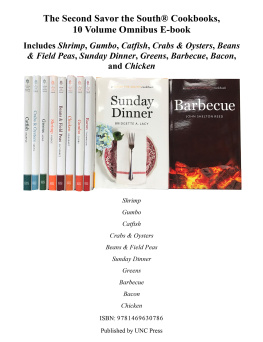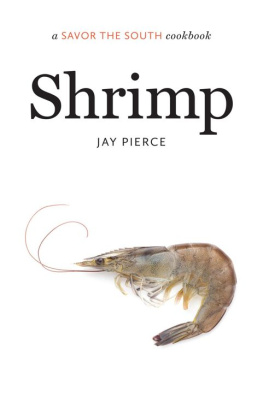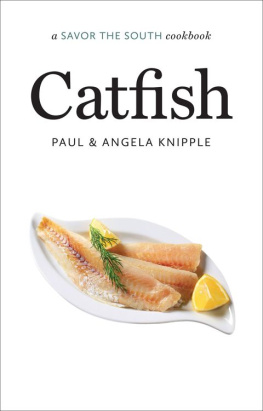The paper in this book meets the guidelines for permanence and durability of the Committee on Production Guidelines for Book Longevity of the Council on Library Resources. The University of North Carolina Press has been a member of the Green Press Initiative since 2003.
Introduction
THE SCIENCE, MYTH, AND MAGIC OF BUTTERMILK, PLUS COOKING TIPS
Like a full moon on a warm southern night, buttermilk makes something special happen. The magical touch of buttermilk creates fluffy pancakes, sweet cakes, and cooling soups. Its the special ingredient for tart ice creams and curry chicken marinades. Buttermilk can become Italian or German cheese. It lends a refreshing flavor to Indian beverages. If youre one of those people who doesnt like the fishy flavor of fish, you need to keep buttermilk in your refrigerator because it mellows the strong taste.
Sure, other things, like moonshine and sweet iced tea, may spring to mind more quickly than buttermilk when thinking about iconic southern liquids. But can a shot of Kentucky bourbon do as much in the kitchen as buttermilk? I dont think so.
Buttermilk is truly representative of the Southboth the traditional South of country farms and the evolving region of creative chefs and international influences. And I believe that buttermilk is an essential ingredient for cooking of all kinds. Without it, there would be no cloud-soft biscuits in which to insert country ham. No silky buttermilk pies. And, heavens, no tender-crispy fried chicken.
In agrarian times, buttermilk was simply the liquid that remained after the butter had been churned out of fresh cream (using an old wooden butter churn and plenty of arm power). So, in a way, the name is a little confusingI guess it should have been called no-butter milk, although a little bit of the butterfat remained behind. But there is much more to the process than just the churning, especially in modern dairy production.
However, the qualities that make buttermilk good for cooking havent changed. The best buttermilk starts with the best milk, of course, and the South is lucky to be seeing a growth in small dairies that produce quality milk. Seek them out to find buttermilk that is rich and thick, with a pleasantly sour flavor reminiscent of yogurt. In fact, good-quality buttermilkthat nice and thick kindcan be substituted for yogurt in recipes. Be sure to adjust the recipe to handle the additional liquid so there is no change in the dishs texture. Yogurt can be a stand-in for buttermilk, too, with the addition of a little liquid.
Read on and Ill tell you about ways to create magic with buttermilk in your own kitchen. My recipes will allow you to bring buttermilk into your life all day long, from breakfast through dinner to sweets and snacks. Youll learn about the history of buttermilk in southern cooking and how todays food fans continue to explore the ingredient. Youll get tips on selecting and using buttermilk so that you get the best flavor in your dishes. Not all buttermilks are the same.
Why Buttermilk?
Many people have asked me why I wanted to write an entire cookbook about buttermilk. My first encounter with buttermilk was the same as that for many southernersseeing my father crumble leftover cornbread into a tall glass, then fill it with buttermilk that was left in the refrigerator after making the cornbread. I tried a spoonful from his glass. It tasted really different, with the chunky texture and lip-puckering flavor of the buttermilk, especially for a kid. (Making that snack was also the closest my father ever came to cooking; he could barely heat up canned soup.) Cornbread was one of the few things my mother would take the time to make from scratch, and she always purchased buttermilk for it. So I grew up thinking that it was a rare but sometimes absolutely necessary thing.
As an adult, after the first time I made buttermilk pancakes for breakfast, there was no going back. Not only did that single ingredient lift average pancakes to a different plane in flavor, but it made them as fluffy and light as a dream. I wanted to know more about that sorcerer buttermilk.
Also, as fabulous as cornbread and pancakes are, I wanted to help people think beyond them, to answer the question that Ive been asked so many times while writing this book: What am I supposed to do with the rest of that carton of buttermilk in my refrigerator? There is so much, people, so much you can do. Ive even talked to some who use it instead of regular milk in their breakfast cereal.
What Is Buttermilk?
Lets start with how the magic happens. What is buttermilk, exactly? The traditional answer is that its whats left after the butter is churned from cream, but the process is more complicated than that. I turned to Lynn G. Turner, emeritus professor of food sciences in the Department of Food, Bioprocessing and Nutrition Sciences at North Carolina State University in Raleigh, for the complete picture.
The old wooden butter churn uses gravity to separate the butter from cream, and the motion of churning makes the fat globules in the cream come together. As the butter forms, the pH of the liquid drops, meaning that it becomes more acidic. The texture and proteins change, and the butter becomes more gel-like as it forms. Churning removes as much liquid as possible from the butter, which typically is about 80 percent fat. After the butter is gone, what remains is the buttermilk, which is fairly acidic and still contains a small amount of fat.
In the days before refrigeration, buttermilk was left sitting outfrugal southerners would never throw it away. Thats when the second part of making buttermilk would take place. Bacteria in the air and on the wooden churn paddle would change the lactose in the buttermilk to lactic acid, and natural fermentation would take place. You hoped the good bacteria outnumbered anything that might cause food-borne illness problems, Turner explained.
In the hot weather of the South, fresh raw milk had a very short shelf life. Natural fermentation would extend the usable life of the buttermilk, and southerners came to relish the tart flavor.
Today, most of the buttermilk you find in supermarkets is not produced by churning. Dairies create it by adding commercial cultures to what older southerners call sweet milk. Usually, dairies add two different culturesthere are several to choose fromto change the lactose to lactic acid. The cultures do what letting a pitcher sit on the kitchen counter used to do, but in a more controlled mannerthey cause the fermentation that gives buttermilk its tart flavor and typical buttery aroma. The quality of cultured buttermilk depends on the raw material, the length of fermentation, the temperature, the type of culture. Its like making wine or cheese, Turner said.
Before manufacturers add the cultures, they give the milk a heat treatment similar to the one used to make yogurt, according to






